We know that HighLevel is one of the most exciting one-stop sales and marketing platforms today. In addition to this, it’s a relatively new but successful company that has managed to carve out a niche for itself in the business software realm.
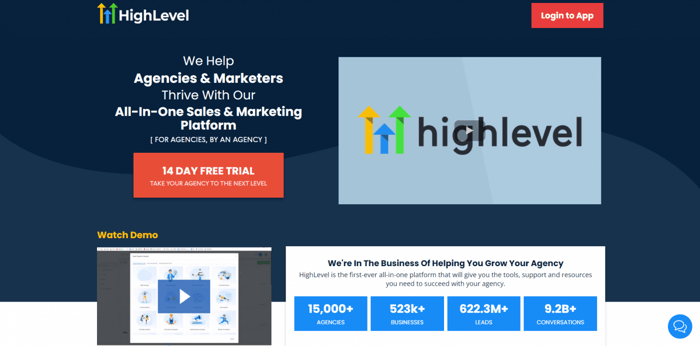
But what in the world is HighLevel White Label? Is it a separate platform? A special feature? An exclusive tool? These are all questions that we’ll tackle in this article.
Table of Contents
What Is White Label?
Let’s start with the term “white label.” What does it even mean?
To break it down very simply, it means that a product developed and produced by one company is sold under the branding (label) of another company.
In the digital marketing world, white labeling is the ability to completely remove a sales and marketing app’s own branding and offer the software to others under your own brand – just as if it were your own app. This way, your clients won’t ever know that you’re actually paying to license someone else’s software, which has a way of looking more professional.
White labeling provides many opportunities for you as a marketer. The obvious one is that it allows you to build much stronger brand awareness. Another one is that it can provide you with opportunities to earn more. With the app completely in line with your brand, you can put a higher price tag on the services you provide through it.
On top of this, the fact that you can white label HighLevel gives you the ability to resell the software. We’ll see later what this means in the context of the HighLevel SaaS mode.
Finally, why would any company want to give a license to others to present and offer its app as its own?
The reason is simple: more profits. White labeling normally costs more than standard sales and marketing app features. It’s a clever way to attract more digital marketing agencies by offering them a chance to elevate their business and brand to the next level.
Now that we know what white label means, we’re ready to understand white labeling specifically with HighLevel. Before we take a look at this HighLevel feature, we’ll explore two more important topics: pricing and who the HighLevel white label option is for.
HighLevel White Label Price
Since HighLevel is available as a separate app on desktop and mobile devices, when it comes to white labeling, the company offers two options: the ability to white label the desktop app and the ability to white label the mobile app.
We’ll explore these extensively in the next section. For now, this is the only distinction we need in order to understand HighLevel’s white label pricing system.
HighLevel offers two pricing plans: Starter and Unlimited. The Starter plan costs $97/month and includes all the features you need to build a website and foster your client leads. The Unlimited plan will cost you $297/month and includes API access. Check out our detailed guide for a deeper look at HighLevel pricing.
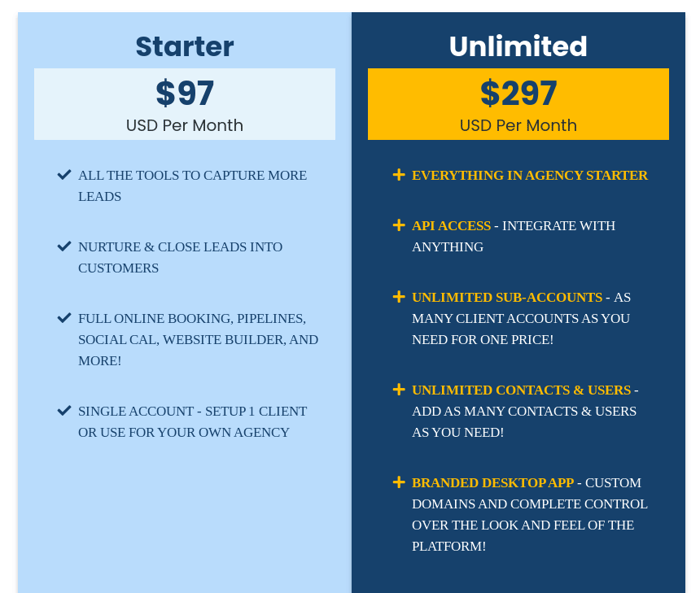
The opportunity to white label the HighLevel mobile app is available through a special plan upgrade – White Label Mobile App + Custom Zap Upgrade.
The upgrade itself costs $497/month. However, since the prerequisite for using it is to already have the Unlimited plan subscription, you’ll pay the upgrade fee in addition to the Unlimited plan fee. This amounts to $794/month.
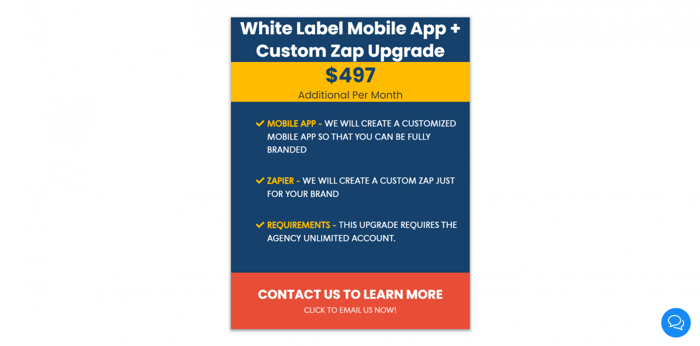
Yet another thing to note is that HighLevel offers a discount on this upgrade if you opt for annual billing. Instead of the regular $5,964 a year, you’ll get the white-labeled app for $4,970/year, which means that the entire fee for two months will be deducted from the total amount you pay. The added advantage over the regular month-to-month billing is that HighLevel won’t charge you anything for the app setup.
With the Unlimited plan and the White Label Mobile App + Custom Zap Upgrade together, you get the chance to fully white label HighLevel. For a large established business, white labeling HighLevel gives you the ability to make a lot of money. For the price of $794/month and the added perks like the custom Zap, this is a great deal.
Of course, not everyone has the budget to afford the perks of the HighLevel white label option, but it should also be noted that not everyone necessarily needs this feature. So, who is this feature suitable for?
Who Is HighLevel White Label For?
As HighLevel itself says, it’s an all-in-one platform “for agencies, by an agency.” This pretty much sums up their main target audience. In addition, virtually wherever you look on the company’s website, you’ll see not-so-subtle hints that HighLevel is primarily geared toward digital marketing agencies.
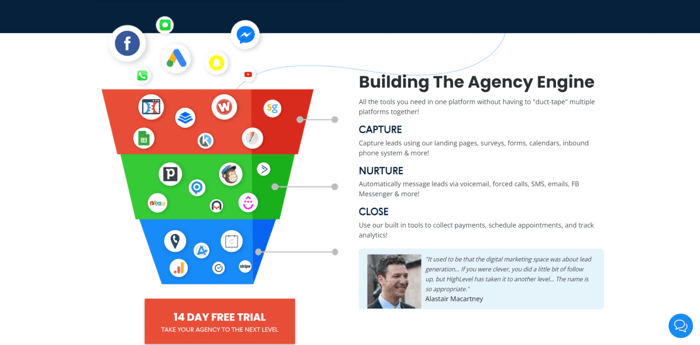
When we consider white labeling as a feature, there’s hardly any other group of businesses that would benefit from white labeling as much as digital marketing agencies. Considering that they’re the ones that sell their special type of service to other businesses, it comes in handy to have their software white labeled.
Additionally, white labeling HighLevel can work well for experienced freelance marketers with a steady customer base as well as larger businesses that have an in-house marketing team but need a sales and marketing app with their own branding.
HighLevel White Label
HighLevel is available as a desktop web app, an Android app, and an iPhone app. The white label feature allows you to make all three apps your own. Let’s see how.
HighLevel White Label Desktop App
To white label the HighLevel desktop app, the first thing you need is a custom white label domain. A custom white label domain (technically subdomain) is the URL that your clients see and type in their browsers when they want to log into their accounts.
Setting up the white label domain is probably the most important aspect of white labeling HighLevel. You want your clients to see a URL without a trace of HighLevel.

To set up the white label domain, you need to be in your agency account. Just click Settings, then Agency Settings, and find Whitelabel Domain. You will enter something along the lines of app.mymaindomain.com. Here’s an example:

The main domain (the part after the app in the example above) is the custom domain you purchase from a DNS/hosting service provider. If you don’t have an existing website, your DNS provider is the company that you bought your custom domain name from, such as GoDaddy, HostGator, or Namecheap.
After you enter your custom HighLevel white label domain, you need to log in to your DNS provider account and update the DNS settings by adding a new CNAME record. Your CNAME should point to app.msgsndr.com.
When you’re done with all of this, you’ll update your agency privacy policy URL and upload your agency logo. You can do both in the Agency Settings section, after which you’ll be all set – you’ll have white labeled HighLevel “down to the URL,” as HighLevel says. Pretty cool, isn’t it?
HighLevel White Label Mobile App
When it comes to the HighLevel mobile apps, you can choose to white label them both – iPhone and Android – or just one. Whichever you choose, there are some things that you need to know beforehand.
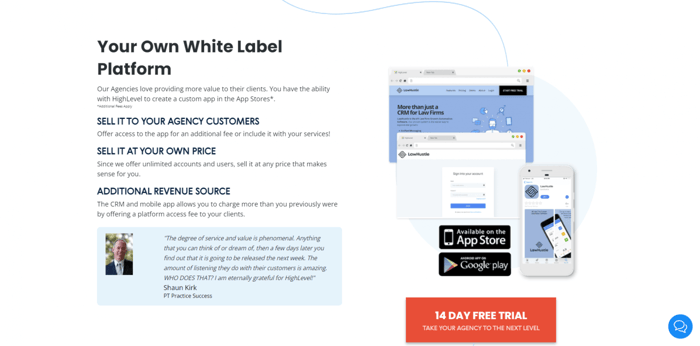
Android
To white label the HighLevel Android app, you have to create a Google Developer account first. The registration process consists of four steps. You can learn more about it in this short yet informative HighLevel guide.
Google charges $25 for a Developer account. The good news is that it’s a one-time payment, so you don’t have to worry about recurring fees. It’s also recommended to use a different Google account from your personal one.
After you create a Google Developer account and pay for the white label mobile app upgrade, you can start working on your HighLevel white label mobile app together with the HighLevel team of developers. According to HighLevel, creating the app, along with publishing it on the Google Play app store, can take up to three weeks.
Keep in mind that when HighLevel says that it will create a customized mobile app for you, this doesn’t mean that you’ll get custom features otherwise unavailable in the HighLevel standard app. What’s customized is the look and feel of the app to match your brand, but the features stay the same as in the regular HighLevel mobile app.
The HighLevel white label mobile app allows you to have your business information and location, as well as functionalities like scheduling and live chat, included in it.
iPhone
Much of what was said about white labeling the HighLevel Android app applies to the iPhone app as well. As you might expect, the biggest difference is setting up an Apple Developer account instead of a Google Developer account.
You need an Apple Developer account because it’s the only way to publish your white labeled app on the App Store.
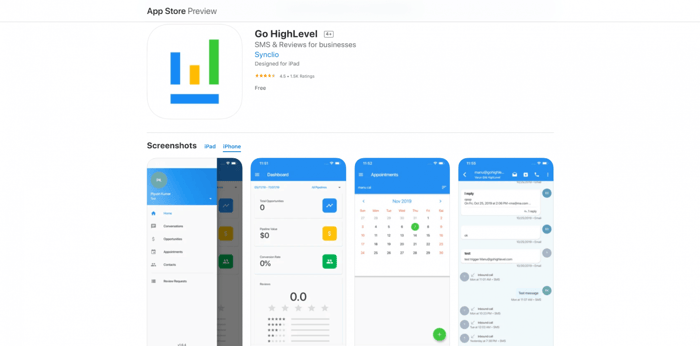
Unlike Google, Apple charges $99 for its Developer account, and it’s a recurring annual fee. Non-profit organizations, educational institutions, and government entities in certain regions (e.g., the US and UK, Italy, Germany, and Brazil) are entitled to an Apple Developer membership at no cost.
Similar to Google, HighLevel recommends using a separate Apple ID for your Developer account. You can find all the necessary information on how to set up an Apple Developer account for your HighLevel white label mobile app in this HighLevel guide.
The rest of what we said about the process of creating and publishing your HighLevel white label app in the previous section applies here as well.
HighLevel White Label and HighLevel SaaS
As we mentioned before, HighLevel has a special feature called SaaS mode. Essentially, the HighLevel SaaS mode is a super-convenient way to resell HighLevel to other users. Just as HighLevel allows you to use its software in return for a certain monthly or annual fee, you can also sell it to other users after first making it your own through the white label option.
In this scenario, you don’t act as an agency or a digital marketer but as a software owner. In other words, you don’t sell your marketing services to businesses, but you sell the HighLevel software as your own, so they can use it as they see fit in exchange for a monthly or an annual subscription – paid to you. In this case, you function in the same way as Shopify, ActiveCampaign, Webflow, and other popular SaaS companies.
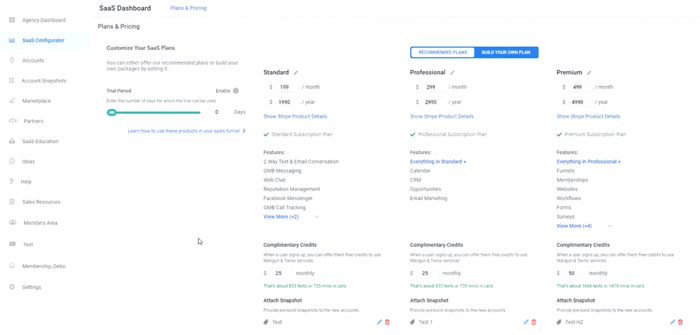
One of the best things about the SaaS mode is that through it, other users and businesses can get access to third-party services available on HighLevel through integration. One such example is DropInBlog, which will allow your subscribers to do content marketing and set up a blog on HighLevel. Other examples include two-way texting, sending voicemail drops and email, and making calls.
Moreover, thanks to the SaaS mode, you can resell not just the HighLevel natively developed software but third-party services like Twilio as well. You can set your own prices to ensure a comfortable profit margin. This is basically one more revenue stream, secured thanks to the possibilities offered by HighLevel.
Now, what does this have to do with white labeling? Well, it would hardly be possible to resell HighLevel and integrated third-party services with HighLevel’s own branding all over the software. The HighLevel white label option is crucial if you want to appear professional and make a profit.
FAQs
What can I do with HighLevel white labeling?
White labeling essentially allows you to rebrand another company's product as your own. So, with HighLevel, that means you can have your label all over the software to claim as your own or even to resell to your customers.
Are there any alternatives to HighLevel white labeling?
There are alternatives out there, each offering a selection of different features and functionality. The alternatives that best match what HighLevel has to offer are:
- Simvoly: offers a more affordable alternative to HighLevel white labeling.
- Vendasta: similar in price to HighLevel and offers an end-to-end marketing platform with a full suite of features.
- Duda: while it doesn’t offer all the same white label functionality as HighLevel it can still be considered a good alternative.
Over and Out
In this HighLevel white label guide, we explored one of the most interesting and, in our opinion, powerful features of HighLevel. At a glance, it may look like a simple idea that doesn’t bring much value to businesses. But upon closer inspection, it is an important business asset, especially for digital marketing agencies.
We hope that this article managed to show the great potential and business value of the HighLevel white label feature as well as the value it brings to digital marketing.




